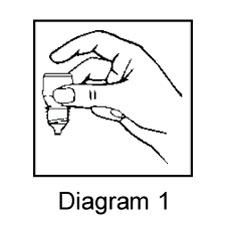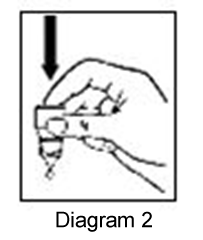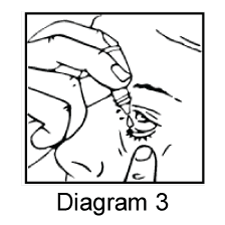SUMMARY CMI
ILEVRO® Eye Drops Suspension
Consumer Medicine Information (CMI) summary
The full CMI on the next page has more details. If you are worried about using this medicine, speak to your doctor or pharmacist.
1. Why am I using ILEVRO?
Ilevro contains the active ingredient Nepafenac. Ilevro is used to for prevention and treatment of post-surgical pain and swelling associated with cataract surgery. It also helps in reducing the risk of post-surgery swelling associated with cataract surgery in patients with non-proliferative diabetic retinopathy (an eye disease)
For more information, see Section 1. Why am I using ILEVRO? in the full CMI.
2. What should I know before I use ILEVRO?
Do not use if you have ever had an allergic reaction to Ilevro or any of the ingredients listed at the end of the CMI.
Talk to your doctor if you have any other medical conditions, take any other medicines, or are pregnant or plan to become pregnant or are breastfeeding.
For more information, see Section 2. What should I know before I use ILEVRO? in the full CMI.
3. What if I am taking other medicines?
Some medicines may interfere with Ilevro and affect how it works.
A list of these medicines is in Section 3. What if I am taking other medicines? in the full CMI.
4. How do I use ILEVRO?
- Your doctor will advise you the appropriate dose.
- Follow the instructions provided and use Ilevro eye drops until your doctor tells you to stop.
- More instructions can be found in Section 4. How do I use ILEVRO? in the full CMI.
5. What should I know while using ILEVRO?
| Things you should do |
|
| Things you should not do |
|
| Driving or using machines |
|
| Looking after your medicine |
|
For more information, see Section 5. What should I know while using ILEVRO? in the full CMI.
6. Are there any side effects?
Common side effects include blurred vision, eye pain, dry or itchy eye(s), feeling that something is in your eye(s) (foreign body sensation), eye irritation, reduced vision, eye discharge.
For more information, including what to do if you have any side effects, see Section 6. Are there any side effects? in the full CMI.
FULL CMI
ILEVRO® Eye Drops Suspension
Active ingredient: Nepafenac 3 mg/mL (0.3%).
Consumer Medicine Information (CMI)
This leaflet provides important information about using ILEVRO. You should also speak to your doctor or pharmacist if you would like further information or if you have any concerns or questions about using ILEVRO.
Where to find information in this leaflet:
1. Why am I using Ilevro?
2. What should I know before I use Ilevro?
3. What if I am taking other medicines?
4. How do I use Ilevro?
5. What should I know while using Ilevro?
6. Are there any side effects?
7. Product details
1. Why am I using ILEVRO?
Ilevro contains the active ingredient Nepafenac. It belongs to class of drug called non-steroidal anti-inflammatory drugs (NSAIDs). They help to reduce pain, swelling.
Ilevro is used for prevention and treatment of post-surgical pain and swelling associated with cataract surgery.
It also helps in reducing the risk of post-surgery macular oedema (buildup of fluid in the macula, an area at the back of the eye) associated with cataract surgery in patients with non-proliferative diabetic retinopathy (an eye disorder, with symptoms such as cloudy or blurred vision, trouble seeing well at night).
2. What should I know before I use ILEVRO?
Warnings
Do not use ILVERO if:
- you are allergic to Nepafenac, or any of the ingredients listed at the end of this leaflet.
- you have an allergy to other nonsteroidal anti-inflammatory drugs (NSAIDs) such as aspirin, ibuprofen.
Allergic reaction symptoms include swelling of the face, lips, tongue or other parts of the body, rash or hives on the skin.
- you have ever experienced asthma (A respiratory problem which causes difficulty in breathing, cough, shortness of breath), hives or acute rhinitis (common cold, symptoms include sneezing, runny nose, sore throat, cough) after using acetylsalicylic acid or other NSAIDs medicines.
- the bottle/packaging shows signs of tampering or the expiry date on the bottle/carton has passed.
Always check the ingredients to make sure you can use this medicine.
Do not use Ilevro eye drops if you are wearing soft contact lenses as the benzalkonium chloride (ingredient in Ilevro) may get absorbed by these lenses and may cause eye irritation and discolour the soft contact lenses.
Do not wear contact lens during the post-surgery period after a cataract surgery unless clearly indicated by your doctor.
Do not use Ilevro eye drops in patients under 18 years of age.
Do not use Ilevro eye drops more than 24 hours prior to surgery or beyond 14 days post-surgery as it may increase the risk of developing unwanted side effects.
Check with your doctor if you:
- have any other medical conditions such as known bleeding tendency or have any bleeding problems or had them in past.
- have any eye infection.
- suffer from any other eye disorder such as any corneal diseases, ocular surface disease e.g. dry eye syndrome (a condition in which your tears are inadequate to provide proper lubrication for your eyes), as it may increase the risk for developing side effects which may become sight threatening.
- have had any complicated eye surgeries or repeated eye surgeries within a short period of time
- suffer from diabetes mellitus
- have rheumatoid arthritis (a joint disease that causes pain, swelling, stiffness in joints)
Use Ilevro eye drops for Ophthalmic use only. Do not use for oral use.
Avoid sunlight during treatment with Ilevro eye drops.
Consult your doctor if you have any other medical conditions or take any other medicines.
During treatment, you may be at risk of developing certain side effects. It is important you understand these risks and how to monitor for them. See additional information under Section 6. Are there any side effects?
Pregnancy and breastfeeding
Check with your doctor if you are pregnant or intend to become pregnant.
Ilevro eye drops are not recommended during pregnancy. They may affect your baby's development and/or childbirth process or your child's development after birth.
Do not use Ilevro eye drops in women of childbearing potential who are not using a contraceptive.
Talk to your doctor if you are breastfeeding or intend to breastfeed.
Ilevro Eye Drops are not recommended during breast feeding.
3. What if I am taking other medicines?
Tell your doctor or pharmacist if you are taking any other medicines, including any medicines, vitamins or supplements that you buy without a prescription from your pharmacy, supermarket or health food shop.
Some medicines may interfere with Ilevro and affect how it works.
Tell your doctor if you take any of the following medicines:
- medicines used for treatment of any other eye problems (prostaglandin analogues drugs e.g. Xalatan, latanoprost)
- any drugs which may prolong the bleeding time.
- topical non-steroidal anti-inflammatory drugs (NSAIDs e.g. Voltaren gel) and topical steroid medicines (e.g. Mometasone)
Check with your doctor or pharmacist if you are not sure about what medicines, vitamins or supplements you are taking and if these affect Ilevro.
4. How do I use ILEVRO?
How much to use
- Follow the instructions provided and use Ilevro eye drops until your doctor tells you to stop.
Dose for the prevention and treatment of pain and swelling:
- Your doctor will advise you the appropriate dose.
- Use 1 drop of Ilevro eye drops in the affected eye(s) once a day, starting from 1 day prior to cataract surgery and continue on the day of surgery.
- Your doctor might administer an additional drop 30 to 120 minutes prior to surgery.
- Do not use Ilevro eye drops greater than 2 weeks and more than once daily.
- If you want to use any other eye drops, wait for at least 5 minutes after using Ilevro eye drops.
- If you want to use any eye ointments, it should be used last.
- Consult your doctor or pharmacist if you do not understand your dose.
Dose for the reduction in the risk of postoperative macular oedema associated with cataract surgery in patients with non-proliferative diabetic retinopathy:
- Your doctor will advise you the appropriate dose.
- Use 1 drop of Ilevro eye drops in the affected eye(s) once daily, starting from 1 day prior to cataract surgery, and continue on the day of surgery and up to 60 days in the post-surgery period as advised by your doctor
- Your doctor might administer an additional drop 30 to 120 minutes prior to surgery.
- Consult your doctor or pharmacist if you do not understand your dose.
When to use ILEVRO
- Ilevro should be used as advised by your doctor.
How to use ILEVRO Eye Drops:
- Sitting or lying down might make putting in your eye drops process simpler.
- Remove contact lenses if you are wearing them before putting in the eye drops.
- Shake the bottle well prior to use.
Follow below steps to use ILEVRO Eye Drops:
- Wash your hands thoroughly with soap and water.
- Before using a bottle for the first time, break the safety seal around the neck area and throw the loose plastic ring away.
- Remove the cap from the bottle.
- After cap is removed, if a tamper evident snap collar is present and loose, remove before using the eye drops.
- Mix the contents of the bottle by inverting 5 to 10 times.
- Hold the bottle upside down in one hand between your thumb and middle finger (see Diagram 1).

- Tilt your head back, gently pull down the lower eyelid of your eye to form a pouch/pocket.
- Place the tip of the bottle close to your eye. Do not touch the tip to your eye as this may cause injury to the eye.
- Do not touch the dropper tip to eyelid or surrounding areas or any surface to avoid contamination of the dropper tip and solution.
- Release one drop into the pouch/pocket formed between your eye and eyelid by gently tapping or pressing the base of the bottle with your forefinger (see Diagrams 2 and 3).


- Gently close your eye. Do not blink or rub your eye.
- When your eye is closed, place your index finger against the inside corner of your eye and press against your nose for about two minutes. This will help to prevent the medicine from draining through the tear duct to the nose and throat, from where it can be absorbed into other parts of your body and may result in a decrease in side effects.
- This will also help to reduce the unpleasant taste sensation that some people experience when using these drops.
- If necessary, repeat the above steps for the other eye.
- It is normal for a small amount of the eye drop to spill onto your cheek since your eyelids can only hold less than one drop at a time. Wipe away any spillage with a tissue.
- Replace the cap on the bottle, closing it tightly.
- Always keep the bottle tightly closed when not in use.
- Wash your hands again with soap and water to remove any residue.
- You may feel a temporary burning sensation in the eye(s) shortly after using Ilevro eye drops.
- Contact your doctor, optometrist or pharmacist immediately if it persists for long time.
- Discard the eye drops after 4 weeks after opening it.
If you forget to use ILEVRO
Ilevro should be used regularly at the same time each day. If you miss your dose at the usual time, one drop should be administered as soon as possible before reverting to the regular dose routine.
If it is almost time for your next dose, skip the dose you missed and take your next dose when you are meant to.
Do not take a double dose to make up for the dose you missed. It may cause unwanted side effects.
If you use too much ILEVRO
If you think that you have used too much Ilevro, you may need urgent medical attention.
If you have accidentally put several drops in your eyes, immediately wash your eyes with warm water.
If you or anyone else have accidently swallowed any, or all the contents of a bottle of Ilevro eye drops You should immediately:
- phone the Poisons Information Centre
(by calling 13 11 26), or - contact your doctor, or
- go to the Emergency Department at your nearest hospital.
You should do this even if there are no signs of discomfort or poisoning.
5. What should I know while using ILEVRO?
Things you should do
Call your doctor straight away if you:
- develop any signs of allergic reactions.
- become pregnant or if you are breast feeding while using Ilevro eye drops.
- have an allergy to other nonsteroidal anti-inflammatory drugs (NSAIDs) such as aspirin, ibuprofen.
- have any other eye problems, corneal diseases, eye infection or take any medicines for eye problems.
Remind any doctor, dentist, pharmacist or optometrist you visit that you are using Ilevro eye drops.
Things you should not do
- Do not stop using this medicine suddenly.
- Do not give Ilevro eye drops to anyone else, even if they seem to have the same condition as you.
- Do not wear contact lens during the post-surgery period after a cataract surgery unless clearly indicated by your doctor.
- Do not use Ilevro eye drops more than 24 hours prior to surgery or beyond 14 days post-surgery as it may increase the risk of developing unwanted side effects.
- Do not use Ilevro eye drops in patients less than 18 years of age.
Driving or using machines
Be careful before you drive or use any machines or tools until you know how Ilevro affects you.
Ilevro eye drops may cause temporary blurred vision or other eye problems in some people.
Wait until your vision clears before driving or using machinery.
Looking after your medicine
- Store Ilevro eye drops below 25°C.
- Protect from light.
- Do not leave the top off the bottle for any time. Put the top back on the bottle immediately after use to avoid any contamination.
Follow the instructions in the carton on how to take care of your medicine properly.
Store it in a cool dry place away from moisture, heat or sunlight; for example, do not store it:
- in the bathroom or near a sink, or
- in the car or on window sills.
Keep it where young children cannot reach it.
When to discard your medicine
Do not use the eye drops after 4 weeks after opening it. Discard any remaining solution after four weeks and open a new bottle every four weeks.
Getting rid of any unwanted medicine
If you no longer need to use this medicine or it is out of date, take it to any pharmacy for safe disposal.
Do not use this medicine after the expiry date.
6. Are there any side effects?
All medicines can have side effects. If you do experience any side effects, most of them are minor and temporary. However, some side effects may need medical attention.
See the information below and, if you need to, ask your doctor or pharmacist if you have any further questions about side effects.
Less serious side effects
| Less serious side effects | What to do |
Eye problems:
Other Problems:
| Speak to your doctor if you have any of these less serious side effects and they worry you. |
Serious side effects
| Serious side effects | What to do |
Eye problems:
| Call your doctor straight away, or go straight to the Emergency Department at your nearest hospital if you notice any of these serious side effects. |
Tell your doctor or pharmacist if you notice anything else that may be making you feel unwell.
Other side effects not listed here may occur in some people.
Reporting side effects
After you have received medical advice for any side effects you experience, you can report side effects to the Therapeutic Goods Administration online at www.tga.gov.au/reporting-problems. By reporting side effects, you can help provide more information on the safety of this medicine.
Always make sure you speak to your doctor or pharmacist before you decide to stop taking any of your medicines.
7. Product details
This medicine is only available with a doctor's prescription.
What ILEVRO contains
| Active ingredient (main ingredient) | Nepafenac |
| Other ingredients (inactive ingredients) | boric acid, propylene glycol, carbomer 974P, sodium chloride, guar galactomannan, carmellose sodium, disodium edetate, hydrochloric acid and/or sodium hydroxide (to adjust pH), water-purified and benzalkonium chloride (0.05 mg/mL) as preservative. |
| Potential allergens | benzoates, sulfur dioxide/sulfites and hydroxybenzoates |
Do not take this medicine if you are allergic to any of these ingredients.
What ILEVRO looks like
Ilevro is a light yellow to yellow, uniform suspension that comes with 4 mL round or oval white (opaque) low density polyethylene (LDPE) bottles with a LDPE dispensing plug and white polypropylene screw cap. Each bottle contains 3 mL eye drops suspension. The bottle may be presented in a pouch.
Who distributes ILEVRO
Novartis Pharmaceuticals Australia Pty Limited
ABN 18 004 244 160
54 Waterloo Road
Macquarie Park NSW 2113
Telephone No. 1800 671 203
www.novartis.com.au
Australian Register Number
AUST R: 230200
AUST R: 309880
® Registered Trademark.
This leaflet was prepared in March 2025.
Internal document code:
(ilv091123c_V2 based on PI ilv091123i)
Published by MIMS June 2025


 The pH of Ilevro is approximately 6.8.
The pH of Ilevro is approximately 6.8.